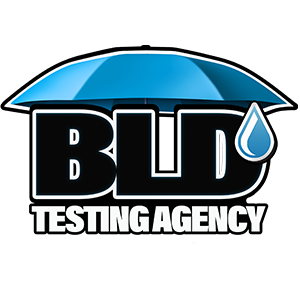Expert Guide to Rain Leak Test Exterior Walls for Leaks: Safeguard Your Home in Los Angeles
Imagine you’re at home, cozy and dry, while a storm rages outside. Suddenly, you notice a faint dripping sound, an unusual dampness on the wall, or even a pool of water forming on the floor. Water intrusion in your home, particularly in the form of rain leaks, can lead to significant damage and costly repairs if not promptly addressed.
This blog post will guide you through the intricacies of rain leak detection, from understanding visual signs of water intrusion to using specialized tools, conducting a rain leak test, preventive measures, and the role of professional services in performing a rain leak test exterior walls for water leaks. Let’s get started!
Key Takeaways
Rain leak tests assess water intrusion due to environmental conditions, employing diagnostic tools like Thermography cameras for non-invasive moisture mapping and moisture meters for precise wetness measurements by a water intrusion specialist in Los Angeles.
A step-by-step guide to conducting a rain leak test includes preparing the exterior walls, simulating rain conditions with calibrated nozzles, and inspecting the walls for indicators of leaks such as water stains and mold.
Preventive maintenance, such as cleaning drainage systems, and gutters, and applying sealants, is crucial to prevent rain leaks, while professional services offer advanced expertise and comprehensive reporting for leak detection and remediation.
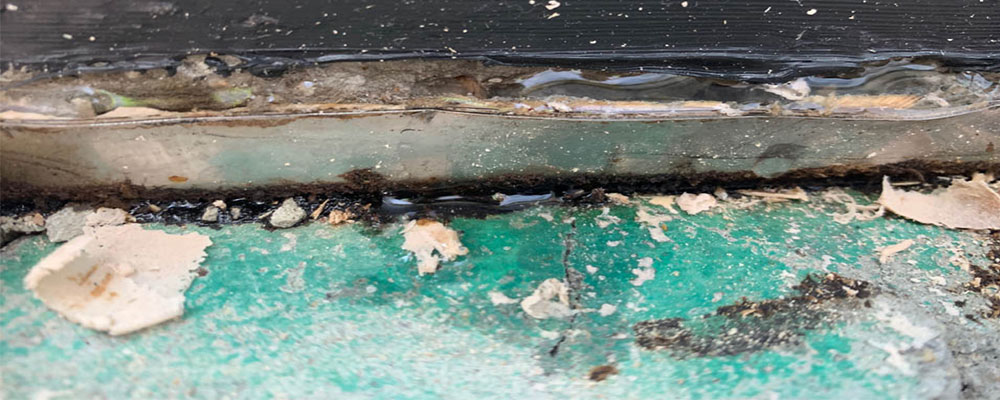
Understanding Rain Leak Detection in Los Angeles
Maintaining a healthy home in Los Angeles relies heavily on rain leak detection, which helps identify potentially damaging water intrusions, particularly in wet walls.
Picture this: you come home after a long day and find moisture stains on your wall, or cracks in porous materials like stucco walls. What do you do? These are visual indications of water intrusion that warrant further investigation for potential rainwater leaks or even a leaky pipe.
The detection of rain leaks is inherently linked to environmental factors, particularly weather conditions. Water intrusion is largely influenced by weather conditions.
Take, for instance, the ASTM E2128 that provides a standardized specification for evaluating water leakage in building walls, considering the impact of different weather conditions. This shows how intertwined the process of water leak testing is with the weather outside
.

Visual Signs of Water Intrusion in Los Angeles
Imagine walking into a room and noticing a conspicuously wet carpet, water stains on the wall, or even bubble-like shapes on the paint. All these signs of moisture intrusion necessitate further investigation by a water intrusion specialist, possibly involving a rain leak test.
Moisture stains could be caused by a variety of factors, including gutter or soffit damage, roof damage, and condensation or leak stains, which may sometimes exhibit blue or purple coloring.
But what about mold? Mold, a silent destroyer, can initiate growth on various surfaces within 24 to 48 hours subsequent to exposure to water. Such growth only occurs with the ideal mix of moisture, nourishment, and temperature, underscoring the necessity of detecting moisture within walls. Moreover, cracks in walls, although not always a result of water intrusion, could be a sign of potential water damage.
As a homeowner, you should also be on the lookout for additional symptoms of water intrusion, such as:
- A musty or humid smell
- Dark or discolored spots
- Warped flooring
- The sound of dripping water
The Role of Weather Conditions
Weather conditions, like heavy rainfall and wind-driven rain, can exacerbate pre-existing vulnerabilities in exterior walls, leading to water-related issues such as moisture inside walls and:
- Mold and mildew buildup, which can undermine the structural integrity of the walls
- Intense precipitation overwhelming structural components like ground sills
- Architectural features with numerous breaks becoming more prone to rain damage
- Prolonged wet conditions in masonry resulting in issues such as moss growth, increased heat loss, and frost damage.
Wind-driven rain in Los Angeles has the potential to infiltrate wall systems, including curtain walls, leading to a range of water-related issues such as:
- Mold and mildew buildup, which can undermine the structural integrity of the walls
- Damage to insulation and drywall
- Rotting of wood framing
- Corrosion of metal components
Severe weather conditions in Los Angeles, including hurricanes, floods, and heatwaves, significantly increase the strain on building enclosures, intensifying pre-existing weaknesses and potentially causing more substantial infrastructure damage, such as a leaking pipe.
Apart from weather-related factors, other factors that can contribute to the occurrence of water leaks include:
- Plumbing issues
- Condensation
- Chimney flaws
- Deteriorating shingles
- Skylights
- Compromised metal components
Diagnostic Tools for Detecting Exterior Wall Leaks
Detecting exterior wall leaks involves the use of specific diagnostic tools. These tools, such as infrared cameras and moisture meters, play a vital role in the precision and efficiency of leak detection.
For instance, thermal cameras use thermal imagery to reveal temperature discrepancies caused by water leaks or moisture intrusion. This facilitates rapid coverage of larger areas, leading to time and cost savings.
On the other hand, moisture meters measure wetness levels in walls using either pins to determine moisture content in drywall or radio frequencies to evaluate the average moisture of a material within its depth of measurement. Measurement depth is about .75 inches in drywall.
Imagine having a tool that could be precise in detecting exterior wall leaks with accuracy levels to within less than 0.1% of the material’s moisture content by weight. That’s the power of a moisture meter when utilized with pin probe testing.
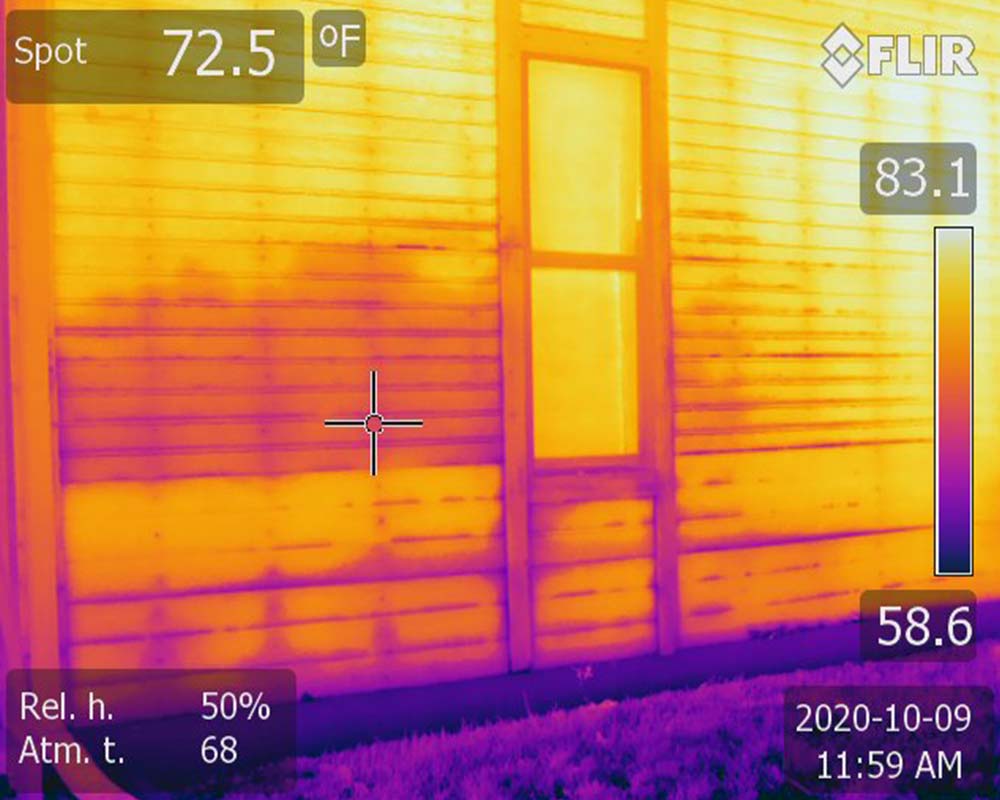
Infrared Cameras: Seeing Beyond the Surface
Infrared cameras detect heat, making them a game-changer in the world of leak detection. They enable the non-invasive detection of water intrusion by identifying temperature variances in building materials.
Imagine being able to see beyond what the naked eye can perceive and detecting potential leaks simply by identifying areas of different hues that correspond to different temperatures.
The interpretation of data from thermal cameras for leak detection involves determining the source of the leak and assessing the extent of damage. However, it’s worth noting that infrared cameras have their limitations; they can only detect the surface temperature of objects and cannot penetrate objects.
False positives are another downfall of infrared cameras. That said, however, it's the actual operator not the limited camera. The limitation is the operator's knowledge and application of infrared science to the object tested.
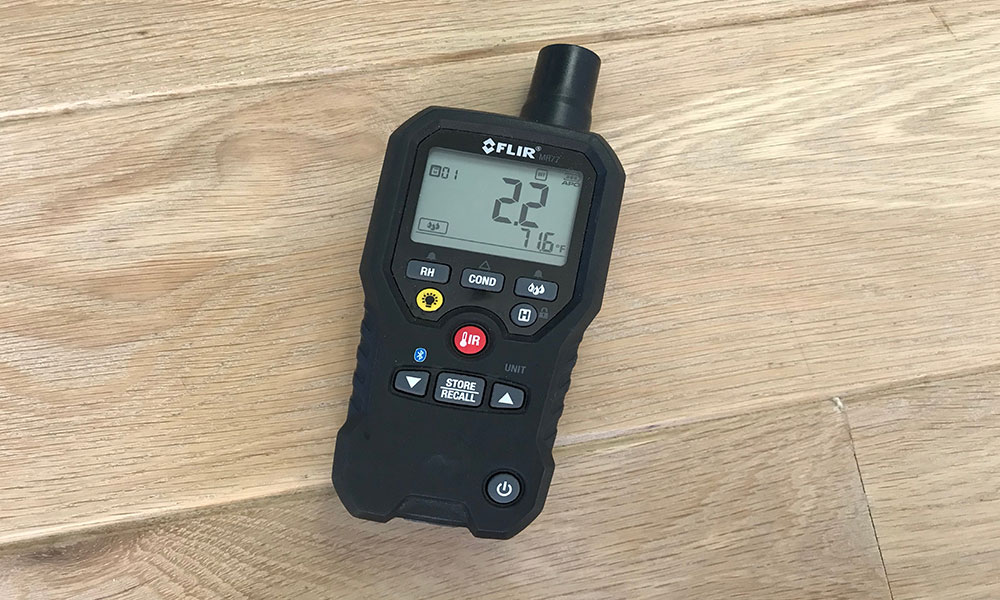
Moisture Meters: Quantifying Wetness Levels
Moisture meters are another essential tool in the kit of every leak detection specialist, along with both a utility knife. These devices quantitatively measure the levels of wetness in walls to accurately identify the source of leaks.
Whether it’s pin-type or pinless, these moisture meters assess moisture content by transmitting an electrical current through the material and gauging its conductivity.
The moisture content of a tested material can be analyzed and estimated based on moisture meter readings presented as numerical values on a reference scale. The potential precision of moisture meters is impressive, with accuracy levels to within less than 0.1% of the material’s moisture content by weight.
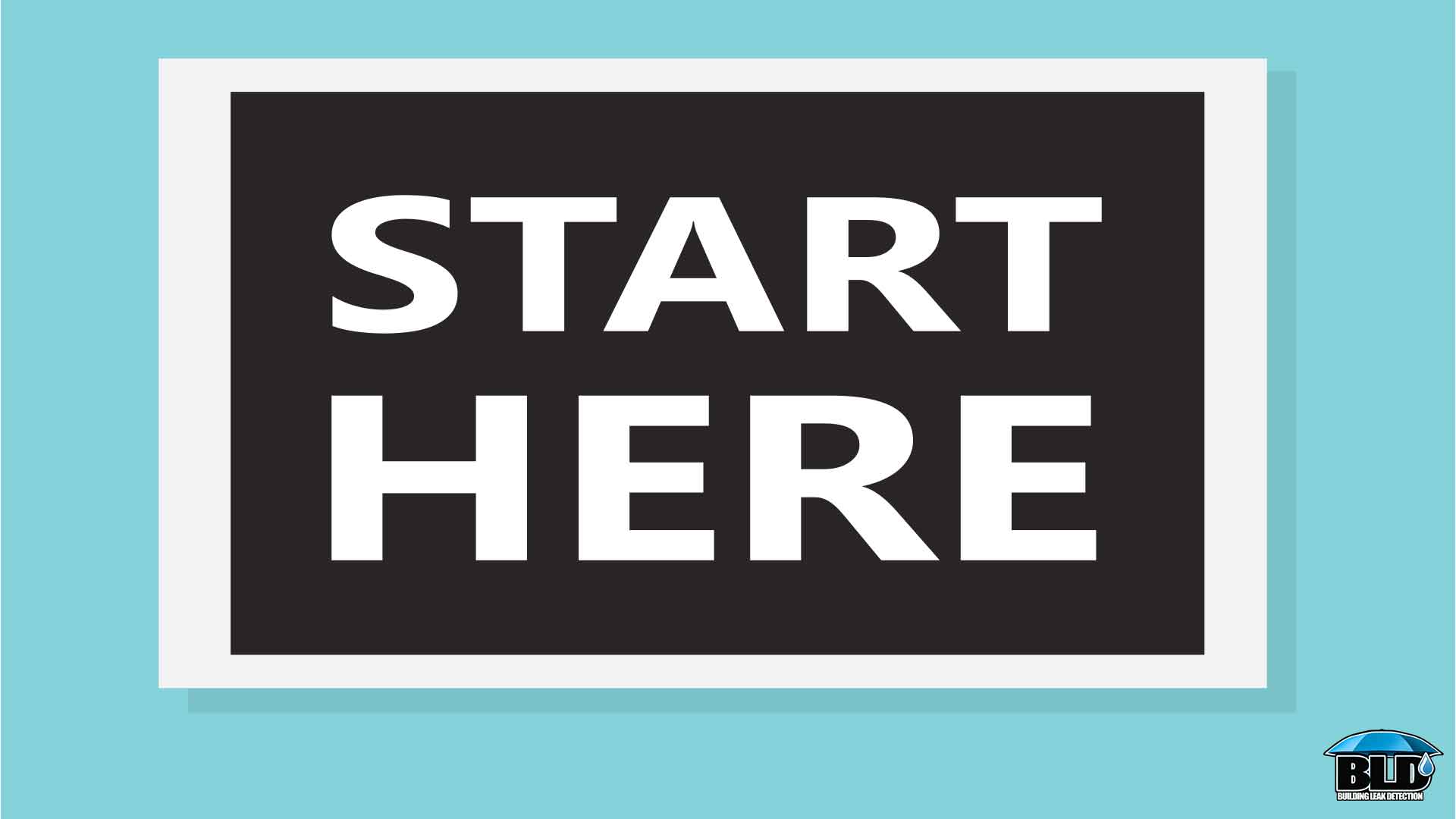
Conducting a Rain Leak Test: Step-by-Step Guide
Armed with the understanding of rain leaks and the tools needed for detection, it’s time to delve into the practical aspect: conducting a rain leak test. This process involves preparing the exterior walls, simulating rain conditions, and inspecting for leak indicators.
Begin the preparation for a rain leak test in Los Angeles by following these steps:
- Use a moisture meter to evaluate the moisture content of various materials in the exterior walls.
- Clean the walls using low-pressure washing and thoroughly inspect them for any signs of damage or obstructions by visual inspection.
- Use AAMA or ASTM simulation testing or large-scale model tests to effectively replicate the impact of rain on the building’s exterior or curtain walls.
- Maintain this simulated rain condition for the final 10 minutes of a 30-minute period to effectively carry out a rain leak test.
Preparing the Exterior Walls
Preparing the exterior walls is a necessary step before conducting a rain leak test. Start by removing any debris or obstructions that might hinder the water flow, such as leaves or physical obstructions.
Cleaning the exterior walls is crucial to prevent significant water damage and to assess the performance of waterproofing products. The recommended method for cleaning involves dampening the surface, applying a cleaning agent, and scrubbing the facade.
Before conducting a rain leak test, it's advisable to:
- Conduct a thorough inspection of the walls for any faults and waterproof them if needed.
- Examine the gutters and downspouts for any blockages.
- Assess the condition of caulking.
- Inspect the roof and flashing around exterior penetrations such as vents and chimneys.
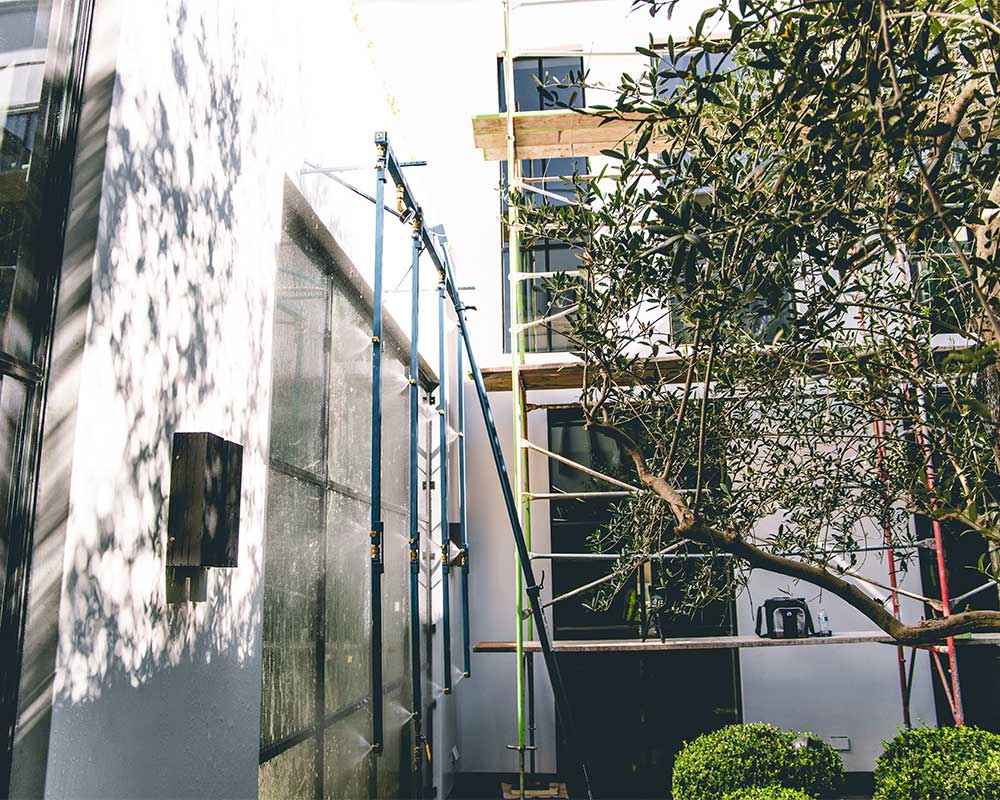
Simulating Rain Leak Testing Conditions in Los Angeles
Though simulating rain conditions for leak detection might seem challenging, it is quite a straightforward task. You only need a calibrated nozzle to spray water on the exterior walls, replicating the conditions that cause water intrusion.
This nozzle is specifically designed for simulating rain conditions in a rain leak test, thereby ensuring precise replication of rain impact on exterior walls.
The water pressure is adjusted by fully opening the single lever ball valve and then controlling the pressure using a pressure regulator valve.
To effectively simulate rain conditions, it's recommended to maintain a distance of 305 mm (12 in.) between the nozzle and the exterior wall during a rain leak test, using a plastic pvc pipe to connect the nozzle to the water source.
Inspecting for Leak Indicators
Once the walls are prepared and rain conditions simulated, inspecting for leak indicators is the next step. This is a crucial step as it aids in pinpointing the origin of water intrusion, leak detection, and potential areas of concern. Typical signs of a rain leak during a test include visible indications of water damage such as:
- Moisture stains
- Water dripping
- Discoloration
- Peeling paint or wallpaper
- Rotted sections in roofing materials or window frame
- The presence of mold or mildew growth
Efficiently pinpointing the source of water intrusion during a rain leak detection test in Los Angeles can be achieved by conducting a water meter test, turning off all faucets, and checking the water meter.
Additionally, inspecting for any wall and floor abnormalities can help reveal the probable source of the leak and allow you to notice water leaks even a small leak.
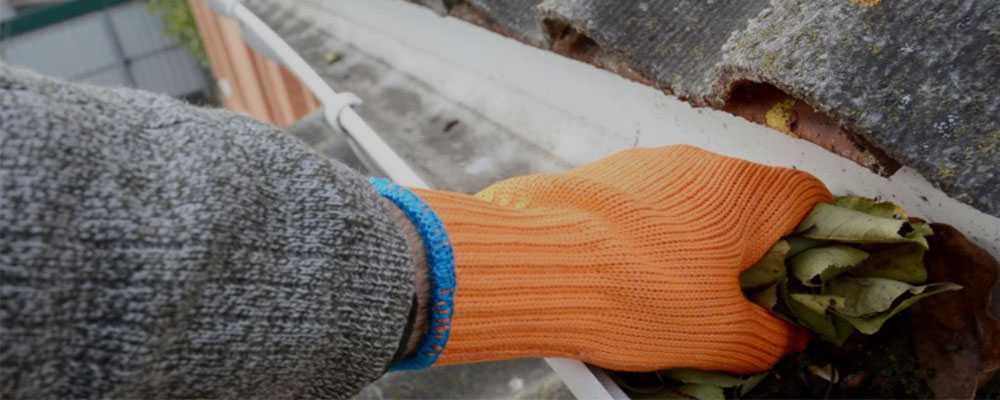
Preventive Measures and Maintenance Tips
Though detection and resolution of rain leaks is crucial, preventive measures should always be prioritized. Preventive measures and maintenance tips for rain leaks include keeping drainage systems clear and applying sealant and protective barriers to vulnerable areas.
Sealants or caulks serve as a solution for addressing rain leaks in walls or window joints, effectively mitigating water damage by establishing a protective barrier in susceptible areas.
For best results, it is recommended that professionals in Los Angeles handle the application of sealants. This ensures proper application and helps in preventing potential water damage. Some recommended sealants for preventing exterior wall leaks, and providing strong and lasting barriers against water intrusion are:
- Latex concrete
- Silicone
- Polyurethane caulks
- Adiseal WATERPROOF SEALANT ADHESIVE
Preventing rain leaks requires regular maintenance of drainage systems. This includes:
- Averting drain blockages
- Enhancing landscape aesthetics
- Promoting plant health
- Preventing water accumulation
- Ensuring proper water flow away from the structure, thus minimizing leak risks.
Keeping Drainage Systems Clear
Regularly clearing gutters and downspouts can be beneficial in preventing water buildup and potential leaks in exterior walls. It is recommended to clear gutters and downspouts at least 1-2 times a year, ideally in the spring and fall, or every few months to prevent rain leaks.
For proper cleaning of gutters and downspouts, follow these steps:
- Begin at the end closest to the downspout and thoroughly spray the entire length of the channel.
- Work your way back towards the downspout, continuing to spray and remove debris.
- Scoop out the gutter contents onto a plastic tarp or drop cloth on the ground.
- Use a garden hose to flush the gutters and downspouts, ensuring any remaining debris is cleared.
Lastly, position your ladder, clean the bottom opening, push out debris, and rinse the gutters.
Sealant and Protective Barriers
Applying sealants and protective barriers to cracks and joints in exterior walls, including foundation wall cracks, can help prevent water intrusion and prolong the life of the building materials. Some recommended waterproof sealants for preventing rain leaks in exterior walls are:
- Adiseal
- Interior sealants
- Plaster waterproofing additives
- Exterior caulk
The process for applying sealants and protective barriers on exterior walls includes:
- Application of the sealant in thin coats using a brush or low-pressure sprayer, while ensuring that excessive application is avoided.
- Cleaning the surface with a damp cloth to remove any dust or residue before applying the sealant.
- For optimal protection, it is recommended to apply sealants and protective barriers to exterior walls every 3-5 years
Professional Rain Leak Detection Services
Professional services from a water intrusion specialist can significantly enhance the effectiveness of rain leak detection. Professional rain leak detection services offer expertise in advanced leak detection techniques and provide comprehensive reporting and solutions for identified issues.
Services like a Water Intrusion Specialist by Building Leak Detection Company in Los Angeles combine visual inspections, thermal imaging, and water-test inspections, adhering to the scientific ASTM E2128 Guideline for evaluating water leakage in building walls.
High efficiency is a hallmark of professional leak detection services. They utilize non-invasive diagnostic technology to swiftly identify leaks, thereby avoiding excessive billable hours associated with invasive techniques.
In addition, professional leak detection companies like Building Leak Detection Company in Los Angeles typically provide exceptional service, which encompasses fast estimating, timely scheduling, and a commitment to not invoicing customers until the job is entirely finished.

Expertise in Advanced Rain Leak Detection
Experienced rain leak detection specialists leverage a combination of advanced tools and industry expertise to pinpoint and diagnose exterior wall leak detection accurately. They utilize advanced tools such as thermal imaging cameras to identify the causes of rain leaks and employ methods like smoke testing or sonar to accurately locate the leaks, offering customers detailed information for targeted solutions.
Professional training is typically necessary for a water intrusion specialist. This might involve completing professional training programs, such as those provided by Building Leak Detection Company in Los Angeles, that cover essential aspects of professional leak detection and the utilization of specialized equipment.
A professional rain leak detection specialist in Los Angeles should also have a comprehensive understanding of ASTM & AAMA test standards, methods, guidelines, and new construction quality control testing for water penetration.
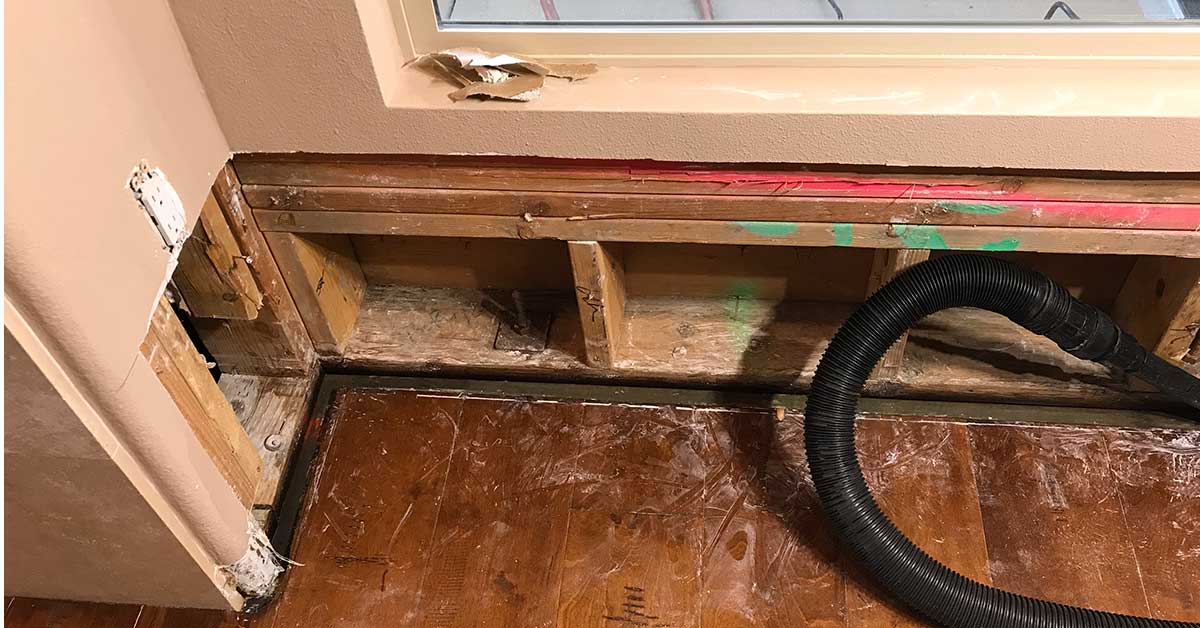
Forensic investigation to test for water infiltration into the walls of a building.
Los Angeles is renowned for its exquisite historic masonry edifices. These antiquated constructions frequently experience water leakage as a result of several possible problems linked to their aged building exteriors. To identify the locations where water is entering, we need to conduct a forensic investigation of the building's external wall system. We aim to replicate leaks that are confirmed to happen.
This form of forensic testing not only generates traceable leaks that can be noticed and rectified, but it is also capable of being replicated. In other words, these tests may be replicated at any given moment to provide identical outcomes.
Furthermore, the testing of wall systems should exclusively be conducted in their present, unaltered state, devoid of any maintenance or repairs. In addition, the testing of the wall may involve a systematic approach, starting with the lower parts and progressing higher.
This process may include separating certain regions of the wall that might be directly impacted by forensic testing in order to avoid generating inaccurate results, such as false positives. Nevertheless, it is necessary to evaluate specific fenestration goods separately at some stage, notwithstanding their proximity to other components. If testing in this method results in leaks, it is necessary to track the leaks back to their source.
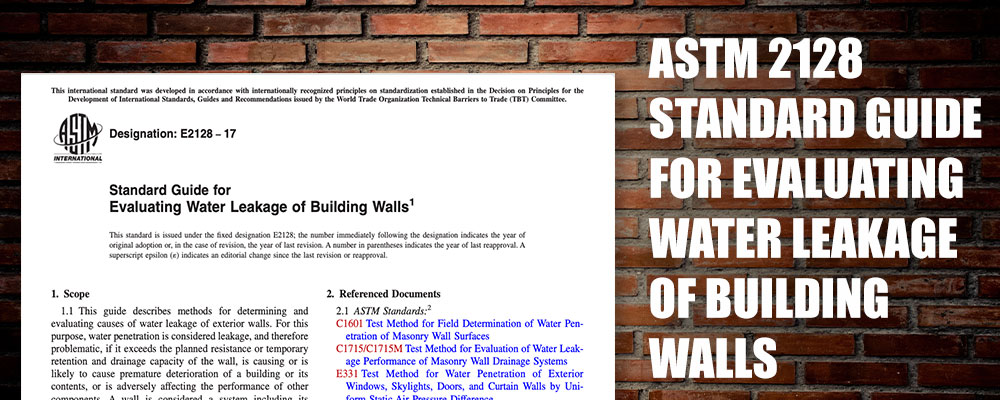
The ASTM 2128
The ASTM 2128 recognizes the necessity of utilizing available techniques to effectively identify water infiltration problems. In several instances, there is no singular test to do this. We are experts in dealing with water infiltration in Los Angeles, where the structures tend to be older. Ancient structures are equipped with antiquated systems. Often, these systems have deteriorated or degraded to the extent that they no longer function properly. Occasionally, there may be a breakdown or malfunction in a particular system.
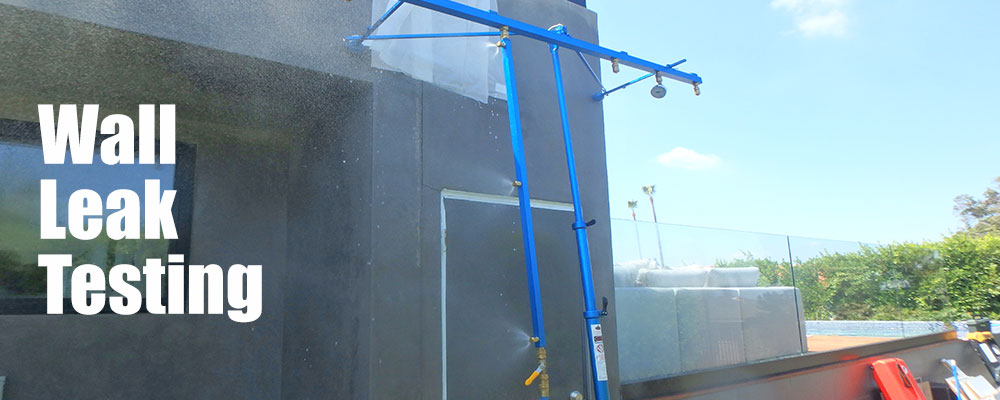
A calibrated spray rack system for masonry wall systems
While the spray rack is primarily utilized in the AMMA and ASTM fenestration testing standards, it may also be employed for exploratory water testing of brick external wall systems. Simultaneously, the utilization of an interior negative air chamber to provide a difference in pressure throughout the thickness of the brick wall is rather infrequent.
The use of calibrated spray rack gear is highly efficient in precisely delivering water to a designated area for a predetermined duration. The spray rack has the capacity to cover an area of 8×8 for spraying and may be effortlessly relocated along the vertical surface of a structure.
Comprehensive Reporting and Solutions
Professional rain leak detection services provide homeowners with comprehensive water intrusion reports, enabling them to grasp the magnitude of the issue and offering bespoke solutions for repair and prevention.
Implementing comprehensive reporting in leak detection provides numerous benefits, including delivering precise quantitative data on leak rates, enabling rigorous quality control measures, reducing the potential for human error, and enhancing understanding of the water distribution system.
A professional water intrusion specialist employs advanced techniques, such as visual inspections, thermography, and water testing, to offer customized solutions for repair and prevention.
Seasoned professionals identify the leak source and offer tailored repair solutions specific to the problem, along with preventive measures like waterproofing and sealing to avert future leaks.
Summary
Rain leak detection is a vital aspect of maintaining a healthy home. From understanding the signs of a water leak or water intrusion and the influence of weather conditions to using diagnostic tools like infrared cameras and moisture meters, conducting a rain leak test, and employing preventive measures, you are now equipped with the knowledge to safeguard your home against rain leaks, water leaks, and water intrusion.
Employing professional services in Los Angeles can provide a more comprehensive solution, offering advanced leak detection and tailored repair strategies. Remember, prevention is always better than cure, and by staying proactive, you can ensure the longevity of your home and the health of its inhabitants.

Frequently Asked Questions
Rain Leak Testing | ASTM E1105, AAMA 501.2 Testing In Los Angeles, California | Phoenix, Arizona | Las Vegas Nevada
